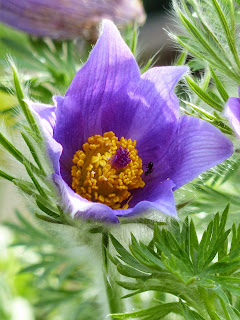Nederlands: Wildemanskruid
Español: Anemone pulsatilla - Pulsatilla común
Français: Anémone pulsatille - Pulsatille vulgaire - Coquerelle
Deutsch: Gewöhnliche Küchenschelle - Gewöhnliche Kuhschelle
Family: Ranunculaceae - Buttercup family
Flowering time: March-June
Height: 5-20cm
Altitude: to 1200m
Colour: lilac to dark purple, bright yellow anthers, central purple spike
Leaves: feathery, covered with long hairs, stem leaves unstalked
Habitat: grazed meadows, generally over limestone
Distribution: central and eastern Great Britain, Belgium, western and southern France, Germany, Denmark, southern Sweden
Note: The flowers of this poisonous plant are large, bell-shaped, erect at first then half-drooping, the petals twice as long as the stamens. As it is one of the first plants to flower it can be found in the presence of snow. Common Pasque Flower became extinct in the Netherlands. The last time it was observed along the rivers Oude IJssel and Gelderse IJssel was in 1968. It is on the Dutch Red List and can now only be found in gardens. It is classified as a Priority Species in the UK Biodiversity Action Plan and as ´vulnerable´ in Britain on the Red Data List. There are a number of subspecies: Pulsatilla vulgaris subsp. costeana (Grands Causses, Massif Central south-central France), Pulsatilla vulgaris subsp. gotlandica (Gotland) and Pulsatilla vulgaris subsp. oenipontana (Karwendel, Innsbruck).
Related key words: Rotterdam, Botanische tuin Kralingen, Thijssepark Amstelveen, Viroin vallei, Röhn in Germany, toxic plant, Alps, alpine plant

